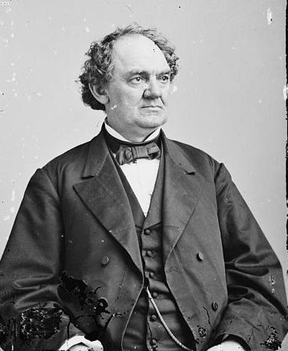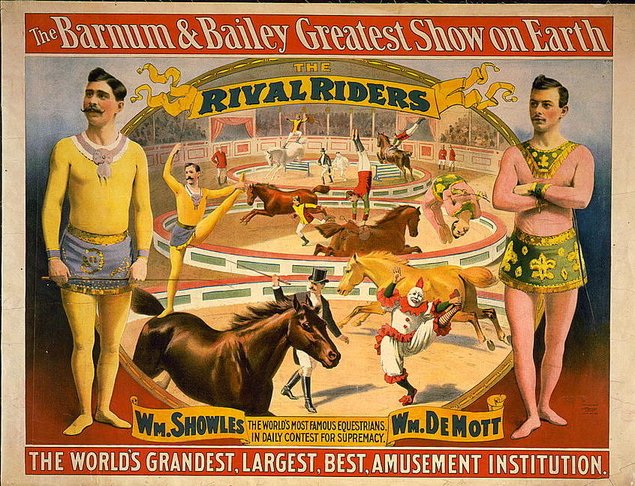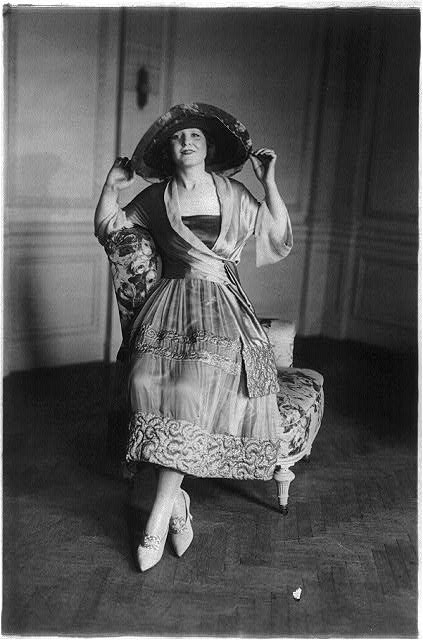end of header
History
You are here: Census.gov › History › Home Page Archive › 2016 › July 2016
2016
July 2016
Visit https://www.census.gov/history every month for the latest Census History Home Page!
U.S. Census Bureau History: P.T. Barnum

July 5 is the birthday of American showman, entrepreneur,
and founder of the Barnum & Bailey Circus, P.T. Barnum.
Photo courtesy of the Library of Congress.
July 5 is the birthday of legendary entrepreneur, showman, and politician Phineas Taylor "P.T." Barnum. Born in Bethel, CT, in 1810, Barnum began his professional career as operator of a general store and founded a weekly newspaper—The Herald of Freedom—in Danbury, CT, in 1831. In 1835, he launched a career in show business (and good-natured fibbing) with the exhibition of Joice Heth, a woman he claimed was the 160-year-old former slave and nurse to President George Washington. Following her death in 1836, Barnum sold tickets to Heth's autopsy and reluctantly admitted the hoax when the doctors proved she was much younger than claimed.
In the years that followed, Barnum purchased curiosities and hired performers to draw crowds to his traveling shows and New York City, NY, museum. In 1871, he founded "P.T. Barnum's Grand Traveling Museum, Menagerie, Caravan & Hippodrome" in Brooklyn, NY. After merging with James Bailey's London Circus in 1881, it became "P.T. Barnum's Greatest Show On Earth, And the Great London Circus, Sanger's Royal British Menagerie and The Grand International Allied Shows United." Shortened to "Barnum & Bailey Greatest Show on Earth" in 1887, it was the largest circus in the world and first to feature three show rings. In 1919, Barnum & Bailey merged with "Ringling Bros. World's Greatest Shows," creating the "Ringling Bros. and Barnum & Bailey Circus."
In addition to his showmanship career, Barnum was also an ardent abolitionist who served two terms in the Connecticut state legislature
representing Fairfield, CT (1865–1869), and mayor of Bridgeport, CT (1875–1876). In Bridgeport, he improved the
city's water and gas utilities and established Bridgeport Hospital  , serving as its first
president in 1878. He died in his sleep in 1891 and is buried at Bridgeport's Mountain Grove Cemetery, which Barnum designed in 1849.
, serving as its first
president in 1878. He died in his sleep in 1891 and is buried at Bridgeport's Mountain Grove Cemetery, which Barnum designed in 1849.
You can learn more about P.T. Barnum, the acts he made famous, and the circus using data collected by the U.S. Census Bureau and other federal agencies. For example:
- P.T. Barnum sought out interesting attractions to draw people to his shows. Some of these included hoaxes like the "FeeJee Mermaid" (half monkey, half fish sewn together) and an unauthorized replica of the "Cardiff Giant"
 (a carved statue purported to be a petrified giant). Human attractions included General Tom Thumb (Charles Stratton) who stood 25 inches tall and weighed 15 pounds; conjoined twins Chang and Eng Bunker; Commodore Nutt (George Washington Morrison Nutt), who stood 29 inches tall; Little Queen Mab (Nellie Keeler), who was 35 inches tall and weighed just 11 pounds; The Thin Man, Isaac Sprague, who weighed just 46 pounds despite his 5 foot 6 inch frame; and Jenny Lind, a
Swedish opera star billed as "The Greatest Singer in the World" according to her 1850 Census
record.
(a carved statue purported to be a petrified giant). Human attractions included General Tom Thumb (Charles Stratton) who stood 25 inches tall and weighed 15 pounds; conjoined twins Chang and Eng Bunker; Commodore Nutt (George Washington Morrison Nutt), who stood 29 inches tall; Little Queen Mab (Nellie Keeler), who was 35 inches tall and weighed just 11 pounds; The Thin Man, Isaac Sprague, who weighed just 46 pounds despite his 5 foot 6 inch frame; and Jenny Lind, a
Swedish opera star billed as "The Greatest Singer in the World" according to her 1850 Census
record.
- The Ringling Brothers—Albert, Augustus, Otto, Alfred, Charles, John, and Henry Ringling— of Baraboo, WI, purchased the Barnum & Bailey Circus in 1907. They operated the Ringling Brothers and the Barnum & Bailey Circuses separately until merging the two in 1919. Today, the Ringling Brothers and Barnum & Bailey Circus, headquartered in Ellenton, Manatee County, FL, bills itself as "The Greatest Show on Earth."
- Gibsonton, a census designated place in Hillsborough County, FL, is famous as a wintering town for circus
performers. Some of the town's residents included Grady Stiles Jr., Aurelio "Al" Tomaini, and Priscilla Lauther.
Many of the towns businesses are run by wintering and retired performers and the town's zoning laws permit residents to keep circus trailers
and elephants on their front lawn. Today, Gibsonton is home to the largest organization for people in the outdoor amusement
industry—the International Independent Showmen's
Association
 .
. - The saying, "There's a sucker born every minute," is erroneously attributed to P.T. Barnum. Some scholars believe the saying originated with David Hannum in reference to Barnum's Cardiff Giant hoax. Although it is difficult to determine the population of "suckers," the Census Bureau's population clock estimates that about eight people are born every minute in the United States.
- It may be difficult to resist buying peanuts or popcorn at the circus. According to the National Peanut Board
 ,
Georgia, Florida, and Alabama grew 70 percent of the nation's peanuts, and the U.S. Department of Agriculture reported that American farmers
grew 785.7 million pounds of popcorn in 2012.
,
Georgia, Florida, and Alabama grew 70 percent of the nation's peanuts, and the U.S. Department of Agriculture reported that American farmers
grew 785.7 million pounds of popcorn in 2012.

The Ringling Brothers—Albert, Augustus, Otto, Alfred, Charles, John, and Henry Ringling— of Baraboo, WI, purchased
the Barnum & Bailey Circus in 1907. They operated the Ringling Brothers and the Barnum & Bailey Circuses separately
until merging the two in 1919. Today, the Ringling Brothers and Barnum & Bailey Circus, headquartered in Ellenton,
Manatee County, FL, bills itself as "The Greatest Show on
Earth."
Photo courtesy of the Library of Congress.

View larger image
Battle of the Somme
July 1 marks the 100th anniversary of the start of World War I's Battle of the Somme.
Between July 1 and November 18, 1916, the battle left more than 1 million wounded or dead, including one of the war's first American fatalities—2nd Lt. Henry Augustus Butters—who joined the Royal Field Artillery in 1915.
Butters died near Guillemont, France on August 31 and was buried at the Meaulte Military Cemetery in Picardie, France.
Photo courtesy of the Imperial War Museum.

View larger image
This Month in Census History
Revealing clothing is not a recent trend according to census data.
On July 1, 1911, the Warsaw, IN, Daily Times attributed a 280 percent increase in the
manufacture of silk to Americans wearing clothing that revealed their ankles.
By 1929, factories produced more than 4.6 billion pairs of stockings annually!
Photo courtesy of the Library of Congress.
Did You Know?
On July 30, 1970, the Census Bureau reported that more Americans lived in suburbs than cities.
The 1960 Census found 32.3 percent of the U.S. population lived in cities and 30.9 percent lived in suburbs. Ten years later, the suburban population grew to 37.6 percent and
the population of cities decreased to 31.4 percent.
Comments or suggestions?




